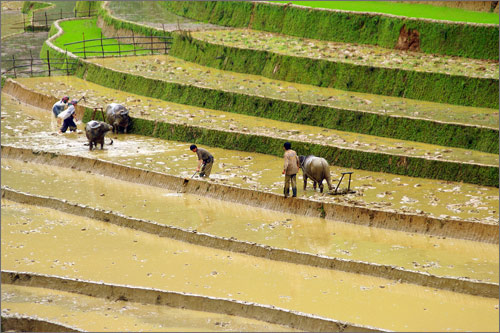Hu tiu, the Chinese rice noodle soup, was imported to Saigon and southern Vietnam by Chinese immigrants centuries ago.
Ask for hu tiu at any Chinese restaurant that serves dim sum (breakfast), and you’ll have a hot bowl of white noodles whose flavor will make your mouth water. On top of the noodles are slices of pork, and on top of the slices are lettuce leaves. Chinese cooks often add small cubes of fried fat to make their hu tiu more delicious.
Use your chopsticks and spoon to take some of the noodles, lettuce and pork each time. As the bowl is served hot, diners have to blow on their first spoonfuls to be able to eat. But that’s the way diners often do with their hu tiu, be they Vietnamese or Chinese.
Saigonese have adopted not only Chinese noodles but also “Cambodian hu tiu.” Called hu tiu Nam Vang (literally Phnom Penh noodles), it may be a variant of the Chinese original. In addition to sliced pork, this kind of hu tiu also has shrimp and sometimes quail eggs. But what makes the Phnom Penh version different from the Chinese are garlic and a special sauce. A lot of fried chopped garlic is used. The distinctive flavor of this version of hu tiu is created by adding a special sour sauce when the hu tiu is served “dry,” which means the broth is put in a separate bowl instead of being poured into the same bowl of noodles.

Like many exotic dishes, hu tiu has been “Vietnamized.” Therefore, apart from Chinese and Phnom Penh hu tiu, Saigonese have their own as well. There are slightly different versions of Vietnamese hu tiu in the provinces of the Mekong Delta. But the most famous of them comes from My Tho, 70km south of HCM City. This version uses stronger noodles as in Phnom Penh hu tiu, but it doesn’t use garlic or sour sauce.
So, what makes one version and one restaurant of hu tiu different from another? Ingredients like pork, shrimp and eggs, count to a certain extent, but not too much. The two key elements are the broth and the noodles. Broth is created mainly from pig bones and a dozen spices. Noodles are made of rice, everyone knows. But only a handful of hu tiu restaurants can offer diners with the quality that pleases every customer’s taste. If you know those secrets, set up a hu tiu restaurant. You’ll be rich in Saigon.
Now you’re asking where to eat hu tiu in town. Well, Saigon Stories once reported that hu tiu has lost its position as Saigonese top breakfast dish. However, there are still several addresses worth trying.
First, Nhan Quan, or Nhan Restaurant. Nhan Quan offers only hu tiu. It’s on Nguyen Trai Street in District 1, near Cong Quynh roundabout.
Lien Hua on Vo Van Tan Street, District 3, is another good place. The ambience is better, and the restaurant is cleaner, though prices are dearer, as you would expect.
Hu Tiu Banh Bao Ong Ca Can on Nguyen Tri Phuong, District 5, is a place tourists on a tight budget should try.
Again, Nhan Quan. But this is different from the one above. Of the same chain, the second Nhan Quan is on Nguyen Thuong Hien Street in District 3. The restaurant is open from 3 p.m. to 5 a.m. the next day. So, if other restaurants serve hu tiu as a breakfast dish, this one is for diners who love to eat hu tiu at night.
So, which one will you choose, Chinese, Cambodian or Vietnamese hu tiu? If you’re hesitating with your choice, you should take this advice: try them all. And, Saigon Stories can assure you, you won’t regret it!

















